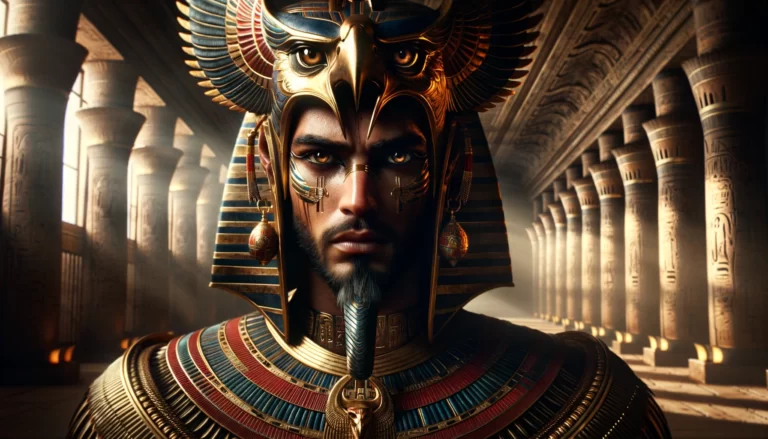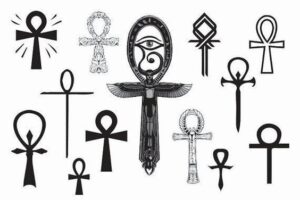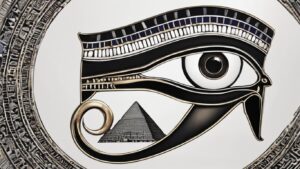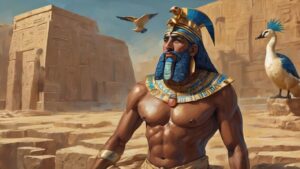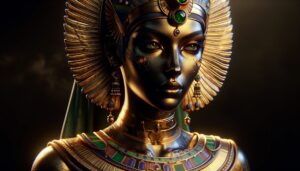Table of Contents
In the realm of ancient Egyptian mythology, Horus stands out as a significant deity, embodying the symbolism of the sky and kingship. Often portrayed as a falcon-headed god, he is intricately associated with protection, pharaohs, and the sun. Horus becomes entangled in a renowned mythic conflict, facing his uncle Seth for the throne of Egypt, thus encapsulating the perpetual struggle between order and chaos.
Moreover, the pharaohs themselves were perceived as the earthly embodiment of Horus, establishing a profound connection that underscored their divine right to rule. This divine association with kingship elevated the significance of Horus in the eyes of ancient Egyptians.
As the sands of time unfolded, the worship of Horus endured for centuries. Throughout different periods in ancient Egyptian history, various forms of this god were acknowledged and revered. The evolving representations of Horus reflected the intricate tapestry of beliefs and cultural shifts that characterized the enduring legacy of ancient Egyptian civilization.
Purpose
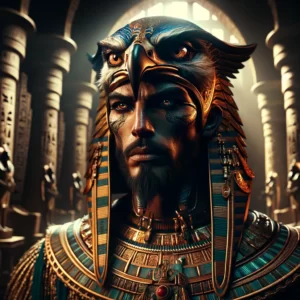
Horus served various purposes in Egyptian mythology. Primarily, he symbolized kingship, the sky, and protection. As a god associated with the pharaohs, he represented the divine authority and legitimacy of the rulers. The myth of Horus battling Seth also conveyed the struggle between order and chaos. Additionally, Horus had a solar aspect, linking him to the sun and its life-giving properties. Overall, Horus played a crucial role in Egyptian religious beliefs, reflecting the significance of kingship and cosmic order in ancient Egyptian culture.
The Birth of Horus
The birth of Horus is a significant myth in Egyptian mythology. According to the myth, Horus was born to the goddess Isis after she magically impregnated herself using the dismembered body parts of her husband Osiris. Osiris had been murdered by his brother Seth, who then scattered his body parts. Isis, with the help of her sister Nephthys and the god Anubis, reassembled Osiris, except for his phallus.
Using her magical abilities, Isis fashioned a substitute phallus and impregnated herself. She later gave birth to Horus in secrecy, hiding him from Seth’s malevolent forces. The myth emphasizes themes of resurrection, divine birth, and the eternal struggle between order (Horus) and chaos (Seth). Horus, when grown, avenged his father Osiris by defeating Seth in a series of battles, ultimately becoming the rightful ruler of Egypt. This myth served to legitimize the divine right of the pharaohs and reinforce the concept of ma’at, the ancient Egyptian principle of cosmic order and justice.
The Battle with Set
The Battle between Horus and Set symbolizes a clash between order and chaos in Egyptian mythology. Driven by chaos, Set murders his brother Osiris, prompting Horus, the rightful heir, to seek revenge. The Ennead, a divine council, oversees their legal dispute, involving challenges to determine Egypt’s rightful ruler.
During the contests, including boat races and battles, the struggle intensifies. Some versions depict a symbolic sexual encounter, highlighting virility and power.
Crucially, Horus’s mother, Isis, supports him, seeking divine intervention, providing guidance, and healing him after battles. The prolonged and multifaceted conflict presents varied challenges, and outcomes aren’t always straightforward. Divine intervention occasionally declares Horus the rightful king.
Symbolically, the battle epitomizes the struggle between cosmic order (ma’at) and chaos, embodying the eternal cycle of death and rebirth.
In various versions, Horus eventually triumphs over Set. Resolutions differ, with some myths emphasizing reconciliation, underscoring the cyclical nature of cosmic order. The Battle with Set, a complex myth, exhibits variations across ancient Egyptian traditions and texts.
Family
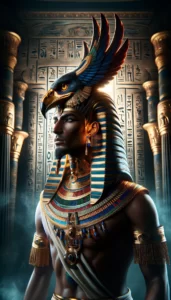
In Egyptian mythology, Horus had several siblings, and the most prominent ones were:
Hathor. Hathor is often considered a sister or a consort of Horus. She is a goddess associated with love, motherhood, and the sky.
Anubis. He is sometimes mentioned as a half-brother to Horus, particularly in versions of the myth where Osiris is his father. Anubis is the god of mummification and the afterlife.
Appearance
In ancient Egyptian art, Horus embodies a falcon-headed deity, symbolizing the sky and divine kingship. His representations feature a falcon-headed figure with a crown or headdress denoting deity or kingship. At times, he appears with a human body and a falcon head.
The Eye of Horus, also called Wedjat or Udjat, holds substantial symbolism. Often portrayed as a stylized eye, it symbolizes protection, healing, and royal power. Esteemed in Egyptian mythology, the Eye of Horus is believed to possess potent protective qualities.
Different forms of Horus existed in Egyptian mythology, including Horus the Elder and Horus the Younger, each associated with different aspects of the divine and royal authority. The representations of Horus evolved over time, and the specific details of his appearance could vary across different periods and artistic styles in ancient Egypt.
Symbology ans Powers
Transitioning from one attribute to another, Horus, a powerful deity in Egyptian mythology, assumes various roles:
In the realm of divine kingship, Horus is revered as the legitimate heir to Egypt’s throne, a position embraced by pharaohs who identify with him.
Transitioning to his role as a protector and warrior, Horus serves as a guardian of the ruling pharaoh and a stabilizing force in the kingdom, engaging in battles against chaotic forces, notably Set.
Aligned with the sun, Horus symbolizes the triumph of light over darkness, reflecting the daily journey of the sun across the sky in solar symbolism.
In the realm of healing and restoration, Horus is linked to the Eye of Horus, believed to possess protective and healing qualities, as portrayed in some myths.
Moving to wisdom and judgment, Horus is associated with justice and order, depicted as a just and wise ruler who participates in legal disputes in certain traditions.
Transitioning to sky symbolism, Horus, with his falcon head, is linked to the sky and heavens, symbolizing divine transcendence through the falcon’s ability to soar high.
These attributes collectively underscore the significance of Horus in Egyptian mythology, portraying him as a multifaceted deity intricately tied to kingship, protection, and cosmic order. The variations in his powers add nuance to the diverse myths and cultural contexts within ancient Egyptian belief systems.
Modern Culture
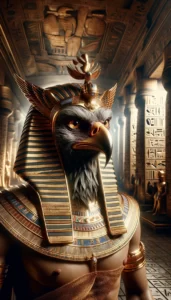
Horus and Egyptian mythology, in general, continue to have a presence in modern popular culture, often appearing in literature, films, video games, and various forms of art. Here are some examples:
Literature:
Horus and Egyptian mythology influence various works of fiction. Authors like Rick Riordan incorporate Egyptian mythology in books such as the “Kane Chronicles” series, introducing characters associated with Horus to a modern audience.
Movies and Television:
Films and TV shows often draw inspiration from Egyptian mythology. For example, in the movie “Gods of Egypt” (2016), Horus is a central character, portrayed as a deity with human and falcon characteristics.
Video Games:
Video games frequently incorporate mythological themes. In the game “Assassin’s Creed Origins,” players encounter Horus as a guiding figure in the game’s ancient Egyptian setting.
Art and Design
Contemporary art and design often feature depictions of Horus and other Egyptian deities. His iconic falcon-headed representation may appear in paintings, sculptures, and various artistic mediums.
Tattoos and Symbolism:
People often choose Egyptian symbols, including representations of Horus, for tattoos. The Eye of Horus, in particular, is a popular symbol with various meanings, including protection and good health.
Fashion and Accessories:
Egyptian motifs, including those associated with Horus, can be found in modern fashion and accessories. Jewelry featuring the Eye of Horus is a common design choice.
Music and Entertainment:
Musicians and performers drawing inspiration from ancient cultures incorporate references to Horus and Egyptian mythology in song lyrics, album artwork, and stage designs.
While the depiction and interpretation of Horus may vary in modern culture, his enduring presence reflects the continued fascination with ancient Egyptian mythology and its rich symbolism.
FAQ
What is the mythological significance of Horus?
Horus plays a key role in Egyptian mythology, representing the eternal struggle between order (ma'at) and chaos. He is associated with the rightful pharaoh's rule and cosmic balance.
How is Horus typically portrayed in ancient Egyptian art?
In ancient Egyptian art, Horus is commonly portrayed as a falcon-headed deity, sometimes with the body of a man. He is often depicted wearing a crown or headdress.
What are the powers and attributes of Horus?
Horus is associated with divine kingship, protection, solar symbolism, healing, wisdom, and judgment. His falcon symbolism also connects him to the sky and divine transcendence.
What is the significance of the conflict between Horus and Set?
The conflict between Horus and Set symbolizes the struggle for cosmic order. Set, representing chaos, murders Horus's father Osiris, leading to a mythic battle for the throne of Egypt.
How are pharaohs connected to Horus?
Pharaohs identified themselves with Horus, considering him a divine king and the legitimate heir to the throne. This association emphasized the pharaoh's divine right to rule.
What is the Eye of Horus, and what does it symbolize?
The Eye of Horus, also known as the Wedjat or Udjat, is a symbol associated with protection and healing. It is believed to have potent qualities in safeguarding and restoring.
How long was the worship of Horus prevalent in ancient Egypt?
The worship of Horus endured for centuries, with various forms of the god recognized across different periods in ancient Egyptian history.
Are there variations in the myths about Horus?
Yes, there are variations in the myths about Horus, reflecting different traditions and cultural contexts within ancient Egyptian belief systems.
